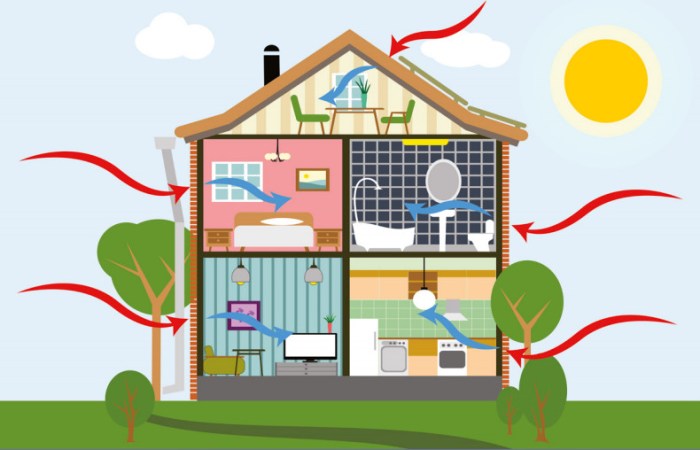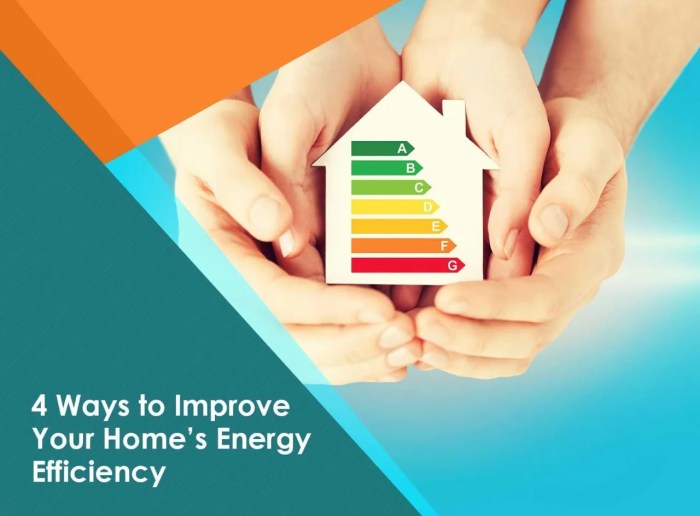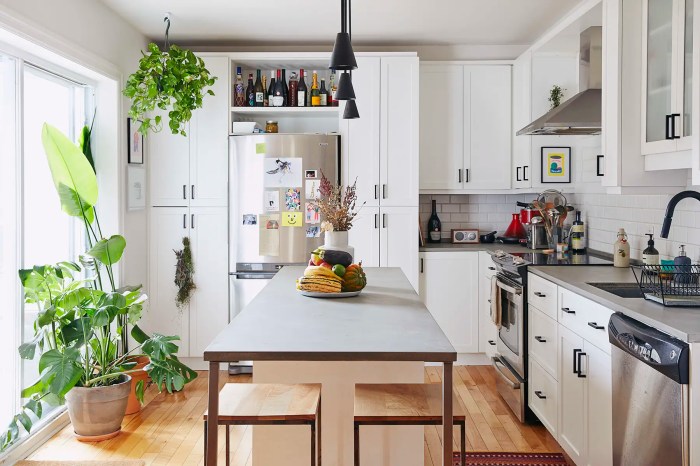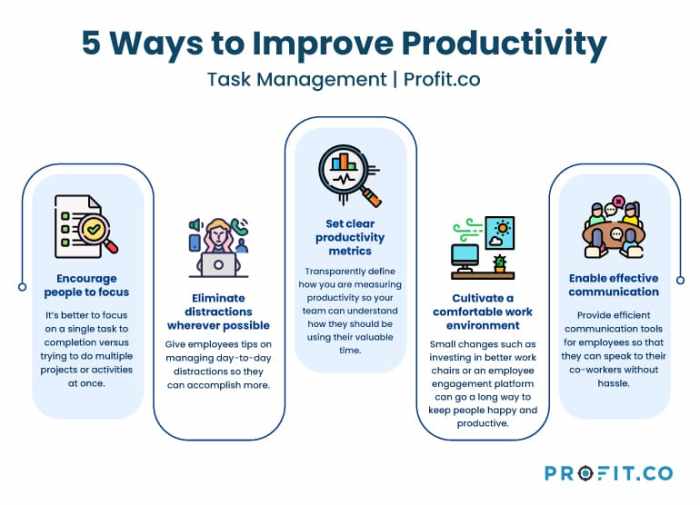
Making your home more energy-efficient can save you money on your utility bills and reduce your environmental impact. From upgrading insulation to installing solar panels, there are many ways to make your home more sustainable and comfortable. This guide will explore various home improvement ideas that can significantly boost your home’s energy efficiency, offering practical solutions and insightful tips for achieving a greener and more cost-effective living space.
By understanding the fundamentals of energy efficiency, you can make informed decisions about the best upgrades for your home. We’ll delve into key areas like insulation, windows and doors, heating and cooling systems, appliances, lighting, water conservation, and renewable energy sources. Whether you’re looking for small, budget-friendly improvements or larger-scale renovations, this comprehensive guide will provide the knowledge and inspiration you need to embark on your energy-efficient home improvement journey.
Insulation and Air Sealing

Insulation and air sealing are crucial for maintaining a comfortable and energy-efficient home. They work together to reduce heat loss in the winter and heat gain in the summer, resulting in lower energy bills and a more pleasant indoor environment.
Insulation Materials
Choosing the right insulation material is essential for achieving optimal energy efficiency. Different materials have varying levels of thermal resistance, known as R-value, which indicates their ability to resist heat flow. Here are some common insulation materials and their characteristics:
- Fiberglass: A popular and cost-effective option, fiberglass insulation comes in batts, rolls, and loose-fill forms. It offers good thermal resistance and is relatively easy to install. However, it can be itchy and irritating to handle.
- Cellulose: Made from recycled paper products, cellulose insulation is a sustainable and environmentally friendly choice. It has a slightly lower R-value than fiberglass but offers excellent sound absorption.
- Mineral Wool: Composed of rock or slag wool, mineral wool insulation is fire-resistant and moisture-resistant. It is often used in commercial buildings and industrial applications.
- Spray Foam: This insulation is applied as a liquid and expands to fill gaps and cavities. It provides a continuous seal, eliminating air leaks and improving energy efficiency. However, it can be more expensive than other options.
- Polystyrene: This foam insulation is lightweight and easy to install. It comes in rigid boards and loose-fill forms and offers good thermal resistance. However, it is not as environmentally friendly as other options.
Air Sealing Techniques
Air sealing involves identifying and sealing gaps and cracks where air can leak into or out of your home. These leaks can significantly reduce energy efficiency, leading to higher heating and cooling costs. Here are some common air sealing techniques:
- Caulking: This involves using a flexible sealant to fill gaps around windows, doors, and other openings.
- Weatherstripping: This involves applying a strip of material to the edges of doors and windows to create a tight seal.
- Foam Sealant: This is a spray-on sealant that expands to fill gaps and cracks, providing a long-lasting seal.
Identifying and Sealing Air Leaks
Air leaks can occur in various areas of your home, including attics, crawl spaces, and basements. To identify air leaks, you can use a smoke pencil, a blower door test, or a thermal imaging camera. Once you’ve identified the leaks, you can seal them using the appropriate techniques.
Tip: For best results, air seal your home before installing insulation. This will prevent air leaks from compromising the effectiveness of the insulation.
Energy-Efficient Windows and Doors
Your windows and doors are major entry points for heat loss in the winter and heat gain in the summer, impacting your home’s energy efficiency. Choosing energy-efficient windows and doors can significantly reduce your heating and cooling costs and contribute to a more comfortable living environment.
Types of Energy-Efficient Windows and Doors
Different types of windows and doors offer varying levels of energy efficiency. Understanding their features and how they perform is crucial for making an informed decision.
- Double- and Triple-Pane Windows: These windows consist of two or three panes of glass separated by air or gas-filled spaces. The additional panes act as insulation barriers, reducing heat transfer and improving energy efficiency. Double-pane windows are generally more affordable than triple-pane, but triple-pane windows offer superior insulation and noise reduction, making them ideal for colder climates or areas with significant noise pollution.
- Low-Emissivity (Low-E) Coatings: Low-E coatings are thin, transparent layers applied to the glass surface that reflect heat back into the room during winter and away from the room during summer. This technology helps reduce heat loss and gain, improving energy efficiency and comfort.
- Gas-Filled Windows: The space between window panes can be filled with gases like argon or krypton, which are better insulators than air. This further enhances energy efficiency by reducing heat transfer.
- Solid Core Doors: Solid core doors provide better insulation than hollow core doors, reducing sound transmission and improving energy efficiency. They are typically made of wood, fiberglass, or composite materials.
- Energy-Efficient Door Designs: Features like weatherstripping, door sweeps, and insulated frames contribute to improved energy efficiency by minimizing air leakage.
High-Efficiency Heating and Cooling Systems
Upgrading your heating and cooling systems can significantly reduce your energy consumption and save you money on your utility bills. High-efficiency systems are designed to use less energy to provide the same level of comfort, resulting in lower operating costs and a smaller environmental footprint.
Traditional vs. High-Efficiency Systems
Traditional heating and cooling systems are often less energy-efficient, relying on older technologies that consume more energy to operate. High-efficiency systems, on the other hand, incorporate advanced technologies like variable-speed motors, improved insulation, and advanced controls to maximize efficiency. This translates to lower energy consumption, reduced emissions, and potentially longer system lifespans.
SEER Ratings
The Seasonal Energy Efficiency Ratio (SEER) rating is a standard measure of a cooling system’s efficiency. A higher SEER rating indicates greater efficiency, meaning the system uses less energy to produce the same amount of cooling. For example, a system with a SEER rating of 16 is more efficient than a system with a SEER rating of 13. The Department of Energy (DOE) has set minimum SEER requirements for new air conditioners, and these standards are constantly being updated to promote energy efficiency.
Benefits of Heat Pumps and Geothermal Systems
Heat pumps are versatile systems that can provide both heating and cooling for your home. They work by transferring heat from one area to another, rather than generating heat like a traditional furnace. Heat pumps can be very energy-efficient, especially in moderate climates. Geothermal systems are a type of heat pump that uses the stable temperature of the earth to provide heating and cooling.
These systems are highly energy-efficient and can significantly reduce your energy bills.
Optimizing Existing Systems
Even if you can’t replace your existing heating and cooling system immediately, there are steps you can take to improve its efficiency.
- Regular maintenance is crucial for keeping your system running efficiently. Schedule annual tune-ups to ensure proper operation and identify any potential issues.
- Change your air filters regularly. Dirty filters restrict airflow and reduce system efficiency.
- Ensure proper insulation and sealing around your home to prevent heat loss in the winter and heat gain in the summer. This will reduce the workload on your heating and cooling systems.
- Consider using programmable thermostats to adjust the temperature automatically based on your schedule. This can help you save energy by reducing heating and cooling when you’re away from home.
Energy-Saving Appliances
Replacing outdated appliances with energy-efficient models can significantly reduce your energy consumption and save you money on your utility bills. Energy-efficient appliances are designed to use less energy while still providing the same level of performance, making them a worthwhile investment for any homeowner.
The Energy Star Program
The Energy Star program, a joint program of the U.S. Environmental Protection Agency (EPA) and the U.S. Department of Energy (DOE), helps consumers identify energy-efficient products. Appliances that meet Energy Star standards are certified to use less energy than standard models. Look for the Energy Star label on appliances to ensure you’re choosing an energy-efficient option.
Choosing Energy-Efficient Appliances
When selecting new appliances, consider their energy efficiency ratings. The Energy Star label provides a clear indication of an appliance’s energy efficiency. Additionally, manufacturers often provide EnergyGuide labels, which display the estimated annual energy consumption and operating costs of the appliance.
- Refrigerators: Choose refrigerators with Energy Star certification and look for features like automatic defrost, adjustable shelves, and door alarms.
- Dishwashers: Select dishwashers with Energy Star certification and features like delayed start, soil sensors, and water-saving cycles.
- Washing Machines: Opt for washing machines with Energy Star certification and features like high-efficiency (HE) washers that use less water and energy.
- Dryers: Choose dryers with Energy Star certification and features like sensor drying, which automatically adjusts the drying time based on the load.
Using Appliances Efficiently
Even with energy-efficient appliances, there are steps you can take to further minimize energy consumption.
- Refrigerators: Keep your refrigerator full, but not overstuffed, and avoid leaving the door open for extended periods.
- Dishwashers: Run full loads and use the air-dry setting to reduce energy consumption.
- Washing Machines: Wash clothes in cold water whenever possible and use the appropriate cycle for the type of laundry.
- Dryers: Clean the lint trap regularly to improve efficiency and avoid overloading the dryer.
Lighting Upgrades
Upgrading your home’s lighting system can significantly impact your energy efficiency and reduce your electricity bills. LED lighting is a game-changer in this regard, offering substantial energy savings and a longer lifespan compared to traditional incandescent bulbs.
LED Lighting Benefits
LED lighting offers numerous advantages over conventional bulbs. Their high energy efficiency translates to lower electricity consumption, leading to significant cost savings on your energy bills. Moreover, LED bulbs last significantly longer than traditional incandescent bulbs, reducing the need for frequent replacements.
Energy Consumption Comparison
Different types of light bulbs consume varying amounts of energy. Here’s a comparison of the energy consumption of LED, CFL, and incandescent bulbs:
| Type | Wattage | Lumen Output | Energy Consumption (kWh/1000 hours) |
|---|---|---|---|
| Incandescent | 60W | 800 lumens | 60 kWh |
| CFL | 13W | 800 lumens | 13 kWh |
| LED | 8W | 800 lumens | 8 kWh |
As you can see, LED bulbs consume significantly less energy than incandescent and CFL bulbs while providing the same amount of light.
Selecting LED Bulbs
Choosing the right LED bulbs involves considering factors like brightness and color temperature.
Brightness
LED bulbs are rated in lumens, which measure the amount of light emitted. A higher lumen rating indicates a brighter bulb. To ensure adequate brightness in a room, consider the size of the space and the desired level of illumination.
Color Temperature
LED bulbs come in various color temperatures, measured in Kelvin (K).
- Warm White (2700-3000K): Provides a warm, inviting glow, suitable for living rooms, bedrooms, and dining areas.
- Soft White (3000-3500K): Offers a slightly cooler white light, ideal for kitchens, bathrooms, and hallways.
- Cool White (4000-4500K): Emits a bright, crisp white light, suitable for offices, garages, and workshops.
- Daylight (5000-6500K): Provides a bright, blue-toned light, similar to natural daylight, often used in task lighting.
Smart Lighting Systems
Smart lighting systems allow you to control your home’s lighting remotely using a smartphone app or voice commands. These systems offer features like:
- Dimming and Color Adjustment: Adjust the brightness and color temperature of your lights to create the desired ambiance.
- Scheduling: Set schedules for lights to turn on and off automatically, optimizing energy use.
- Automation: Integrate your lighting system with other smart home devices for automated lighting control based on your preferences or environmental conditions.
Smart lighting systems can enhance energy efficiency by enabling you to turn off lights when not in use and adjust the brightness based on your needs.
Water Conservation Measures
Water conservation is an essential aspect of energy efficiency, as it directly impacts our energy consumption. Reducing water usage lowers the demand on water treatment plants, which often rely on energy-intensive processes. Furthermore, water conservation can significantly decrease the energy required to heat or cool water for domestic use.
Water-Saving Fixtures
Installing water-saving fixtures is a simple yet effective way to conserve water. These fixtures are designed to reduce water flow without compromising performance.
- Low-flow showerheads: These showerheads use less water per minute while maintaining a comfortable shower experience. They typically use 1.75 gallons per minute (gpm) or less, compared to standard showerheads that use 2.5 gpm.
- Low-flow toilets: Modern toilets with dual-flush systems use less water per flush, typically 1.28 gallons or less. Older toilets can use up to 5 gallons per flush, making them a significant source of water waste.
- Aerators for faucets: These small devices attach to faucets and mix air with water, creating a more forceful stream while using less water. They can reduce water usage by up to 50%.
Water-Saving Landscaping and Gardening
Water-wise landscaping practices can dramatically reduce outdoor water consumption.
- Choose drought-tolerant plants: Opting for native or adapted plants that thrive in your region’s climate requires less watering.
- Implement drip irrigation: Drip irrigation systems deliver water directly to the roots of plants, minimizing evaporation and runoff.
- Mulch your garden beds: Mulch helps retain soil moisture, reducing the need for frequent watering. It also prevents weed growth, further reducing water usage.
Identifying and Fixing Leaks
Leaks in plumbing systems can waste significant amounts of water and increase energy consumption.
- Check for dripping faucets: A dripping faucet can waste hundreds of gallons of water per year. Tighten the faucet handle or replace the washer to fix the leak.
- Inspect toilets for leaks: Add a few drops of food coloring to the toilet tank. If the color appears in the bowl within 30 minutes, there’s a leak in the tank. Replacing the flapper or other components can fix the leak.
- Listen for unusual noises: Running water sounds or gurgling noises can indicate leaks in pipes or fixtures. Contact a plumber to diagnose and repair the leaks.
Renewable Energy Sources

Harnessing the power of nature, renewable energy sources offer a sustainable and environmentally friendly way to power your home. Solar panels, wind turbines, and other renewable energy systems can significantly reduce your reliance on fossil fuels, lowering your energy bills and minimizing your carbon footprint.
Solar Energy
Solar panels convert sunlight directly into electricity through the photovoltaic effect. The amount of energy generated depends on factors such as panel size, sunlight intensity, and geographic location. Solar panels are a popular choice for homeowners, as they offer a reliable and clean source of energy.
Benefits of Solar Energy
- Reduced Energy Bills: Solar panels can significantly reduce your monthly electricity bills, and in some cases, you may even eliminate them altogether.
- Environmental Sustainability: Solar energy is a clean and renewable source of energy, emitting no greenhouse gases or pollutants.
- Increased Home Value: Homes with solar panels are generally more attractive to potential buyers, leading to a higher resale value.
Limitations of Solar Energy
- Initial Investment: Installing a solar panel system can be expensive, although government incentives and rebates can help offset the cost.
- Weather Dependence: The amount of electricity generated by solar panels varies depending on weather conditions, particularly sunlight intensity and cloud cover.
- Space Requirements: Solar panels require a significant amount of roof space or land area to generate enough electricity to meet your home’s energy needs.
Wind Energy
Wind turbines harness the kinetic energy of wind to generate electricity. The amount of energy produced depends on factors such as turbine size, wind speed, and wind resource availability.Wind turbines are becoming increasingly common in residential areas, particularly in regions with consistent wind speeds.
Benefits of Wind Energy
- Clean and Renewable: Wind energy is a clean and renewable source of energy, producing no greenhouse gases or pollutants.
- Low Operating Costs: Once installed, wind turbines have relatively low operating costs, making them a cost-effective source of energy.
- Reduced Carbon Footprint: By replacing fossil fuels with wind energy, you can significantly reduce your carbon footprint and contribute to a healthier environment.
Limitations of Wind Energy
- Intermittency: Wind energy is intermittent, meaning that the amount of electricity generated can fluctuate depending on wind speed and direction.
- Visual Impact: Wind turbines can be visually intrusive, especially in residential areas, and may be considered aesthetically displeasing by some people.
- Noise Pollution: Wind turbines can generate noise, which can be a concern for nearby residents, especially during high wind conditions.
Other Renewable Energy Sources
Besides solar and wind energy, other renewable energy sources are available for home use, such as:
Geothermal Energy
Geothermal energy harnesses the heat from the Earth’s core to generate electricity. This is a reliable and sustainable source of energy, but it is not widely available in all locations.
Hydropower
Hydropower utilizes the flow of water to generate electricity. Small-scale hydropower systems, such as micro-hydro turbines, can be installed on streams and rivers to provide electricity for homes.
Biomass Energy
Biomass energy is derived from organic matter, such as wood, crops, and waste. Biomass can be burned to generate electricity or heat, offering a renewable and carbon-neutral source of energy.
Choosing and Installing Renewable Energy Systems
When choosing and installing a renewable energy system, it’s essential to consider several factors, including:
Energy Needs
Determine your home’s energy consumption and choose a system that can generate enough electricity to meet your needs.
Budget
Renewable energy systems can vary in cost, so it’s important to set a realistic budget and explore financing options.
Location and Climate
Consider your location’s climate and sunlight or wind availability when selecting a system.
Professional Installation
Always choose a qualified and experienced installer to ensure proper installation and optimal system performance.
Government Incentives and Rebates
Many governments offer financial incentives and rebates to encourage homeowners to adopt renewable energy systems. These incentives can significantly reduce the upfront cost of installation, making renewable energy more accessible.It’s crucial to research available incentives in your area and explore eligibility requirements.
Home Improvement Straw
Straw bale construction, a sustainable and eco-friendly building method, involves using compressed bales of straw as a primary building material for insulation and structural support. It has gained popularity as a cost-effective and environmentally conscious alternative to conventional building materials.
Environmental Benefits
Using straw bales offers numerous environmental benefits, making it a sustainable choice for home improvement.
- Reduced Carbon Footprint: Straw, an agricultural byproduct, is a renewable resource that sequesters carbon dioxide during its growth. Using it as a building material reduces the reliance on energy-intensive materials like concrete and steel, minimizing the carbon footprint of construction.
- Sustainable and Renewable: Straw is readily available and can be sourced locally, reducing transportation costs and emissions. It’s a renewable resource that can be replenished annually, promoting sustainable building practices.
- Reduced Waste: Utilizing straw bales helps divert agricultural waste from landfills, contributing to waste reduction and resource recovery.
- Energy Efficiency: Straw bale walls provide excellent thermal insulation, keeping homes cool in summer and warm in winter. This reduces reliance on heating and cooling systems, leading to lower energy consumption and reduced energy bills.
Construction Process
Constructing a straw bale home involves a specific process that ensures structural integrity and energy efficiency.
- Design: The design phase involves creating a plan that considers the size, shape, and orientation of the house to maximize energy efficiency and natural light. Straw bales are often used for exterior walls, but can also be used for interior walls and even roofs.
- Foundation: A strong foundation is crucial for supporting the weight of the straw bale walls. Concrete or timber foundations are typically used, depending on the soil conditions and the design of the house.
- Insulation: Straw bales themselves provide excellent insulation, but additional insulation may be required in certain climates. Insulation can be added to the interior or exterior of the walls, depending on the design.
- Finishing: Once the straw bale walls are in place, they are typically finished with a layer of plaster or stucco to create a smooth and durable surface. This also helps to protect the straw bales from moisture and damage.
Durability and Fire Resistance
Straw bale construction offers both durability and fire resistance when implemented correctly.
- Durability: Straw bales are surprisingly durable, offering good resistance to pests, rot, and moisture when properly protected. They are also resilient to earthquakes and wind damage.
- Fire Resistance: Straw bales are naturally fire-resistant, as they contain high levels of silica. However, it’s important to use fire-retardant treatments and follow proper building codes to ensure adequate fire safety.
Embracing energy-efficient home improvements is a smart investment that benefits both your wallet and the environment. By implementing these strategies, you can create a more sustainable and comfortable living space while reducing your reliance on fossil fuels. Remember, every step you take towards energy efficiency contributes to a healthier planet and a brighter future. So, take the initiative, explore the possibilities, and make your home a beacon of energy efficiency and environmental consciousness.
FAQ Overview
What is the best way to determine the energy efficiency of my home?
A home energy audit conducted by a qualified professional can assess your home’s energy use and identify areas for improvement. This audit will pinpoint areas where heat is escaping, such as drafty windows or poorly insulated walls, and provide recommendations for upgrades.
Are there any government incentives or rebates for energy-efficient home improvements?
Yes, many government programs offer tax credits, rebates, and incentives for installing energy-efficient appliances, windows, insulation, and renewable energy systems. Check with your local utility company or the Department of Energy for available programs in your area.
How can I make my home more energy-efficient on a budget?
There are many affordable ways to improve your home’s energy efficiency. Start by making simple changes like sealing air leaks around windows and doors, using energy-efficient light bulbs, and setting your thermostat a few degrees lower in the winter and higher in the summer. You can also consider upgrading appliances with higher Energy Star ratings as they become available.




